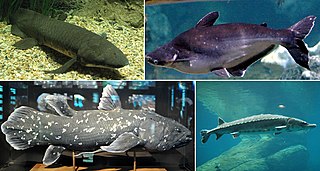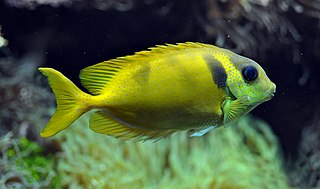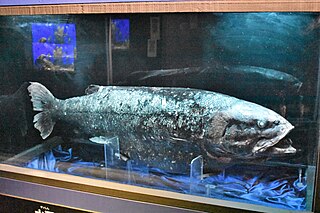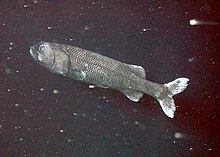
Actinopterygii, members of which are known as ray-finned fish or actinopterygians, is a class of bony fish that comprise over 50% of living vertebrate species. They are so called because of their lightly built fins made of webbings of skin supported by radially extended thin bony spines called lepidotrichia, as opposed to the bulkier, fleshy lobed fins of the sister class Sarcopterygii. Resembling folding fans, the actinopterygian fins can easily change shape and wetted area, providing superior thrust-to-weight ratios per movement compared to sarcopterygian and chondrichthyian fins. The fin rays attach directly to the proximal or basal skeletal elements, the radials, which represent the articulation between these fins and the internal skeleton.

Osteichthyes, also known as osteichthyans or commonly referred to as the bony fish, is a diverse superclass of vertebrate animals that have endoskeletons primarily composed of bone tissue. They can be contrasted with the Chondrichthyes and the extinct placoderms and acanthodians, which have endoskeletons primarily composed of cartilage. The vast majority of extant fish are members of Osteichthyes, being an extremely diverse and abundant group consisting of 45 orders, over 435 families and 28,000 species. It is the largest class of vertebrates in existence today, encompassing most aquatic vertebrates, as well as all semi-aquatic and terrestrial vertebrates.

Salmonidae is a family of ray-finned fish that constitutes the only currently extant family in the order Salmoniformes, consisting of 11 extant genera and over 200 species collectively known as "salmonids" or "salmonoids". The family includes salmon, trout, char, graylings, freshwater whitefishes, taimens and lenoks, all coldwater mid-level predatory fish that inhabit the subarctic and cool temperate waters of the Northern Hemisphere. The Atlantic salmon, whose Latin name became that of its genus Salmo, is also the eponym of the family and order names.

Deep-sea fish are fish that live in the darkness below the sunlit surface waters, that is below the epipelagic or photic zone of the sea. The lanternfish is, by far, the most common deep-sea fish. Other deep-sea fishes include the flashlight fish, cookiecutter shark, bristlemouths, anglerfish, viperfish, and some species of eelpout.

The Saccopharyngiformes are a derived lineage of unusual eels within the order Anguilliformes, and includes families Cyematidae, Monognathidae, Eurypharyngidae, Saccopharyngidae, and the proposed family Neocyematidae. Most of the fish in this group are deep-dwelling and rarely seen, typically known from only a handful of specimens. Species include recognizable fish such as pelican eels and bobtail eels. Some can live deep in the ocean, well into the aphotic zone, approximately 500 to 1,800 meters deep. Extensive research has not been conducted on them due to being indirectly observed, with some species known only from their larvae. All families except for the exceptionally rare individuals of proposed family Neoceymatidae are found in all major oceans.

Synbranchiformes, often called swamp eels, though that name can also refer specifically to Synbranchidae, is an order of ray-finned fishes that are eel-like but have spiny rays, indicating that they belong to the superorder Acanthopterygii.

Neopterygii is a subclass of ray-finned fish (Actinopterygii). Neopterygii includes the Holostei and the Teleostei, of which the latter comprise the vast majority of extant fishes, and over half of all living vertebrate species. While living holosteans include only freshwater taxa, teleosts are diverse in both freshwater and marine environments. Many new species of teleosts are scientifically described each year.

The Osmeriformes are an order of ray-finned fish that includes the true or freshwater smelts and allies, such as the galaxiids and noodlefishes; they are also collectively called osmeriforms. They belong to the teleost superorder Protacanthopterygii, which also includes pike and salmon, among others. The order's name means "smelt-shaped", from Osmerus + the standard fish order suffix "-formes". It ultimately derives from Ancient Greek osmé + Latin forma, the former in reference to the characteristic aroma of the flesh of Osmerus.

Slickheads, also known as nakedheads or smoothheads, are deep water fishes that belong to the family Alepocephalidae. They are most commonly found in the bathypelagic layer, which is approximately 3000m below the surface. They get their name from the lack of scales on their heads. Similarly, the scientific name is from the Greek ᾰ̓- (a-, "not"); λέπος (lepos, "scale"); and κεφαλή (kephalē, "head"). It has about 22 genera with ca. 96 species.

Fish are very diverse animals and can be categorised in many ways. Although most fish species have probably been discovered and described, about 250 new ones are still discovered every year. According to FishBase about 34,800 species of fish had been described as of February 2022, which is more than the combined total of all other vertebrate species: mammals, amphibians, reptiles and birds.

The Argentiniformes is an order of marine ray-finned fish whose distinctness was recognized only fairly recently. In former times, they were included in the Osmeriformes as suborder Argentinoidei. That term refers only to the suborder of marine smelts and barreleyes in the classification used here, with the slickheads and allies being the Alepocephaloidei. These suborders were treated as superfamilies Argentinoidea and Alepocephaloidea, respectively, when the present group was still included in the Osmeriformes.

Narcetes is a genus of slickheads. It was formally described by Alfred William Alcock in 1890. It currently contains six described species.
Edward Orlando Wiley III is the curator emeritus of ichthyology at the University of Kansas Biodiversity Institute and professor of systematics and evolution for the Department of Ecology and Evolutionary Biology at the University of Kansas. His master's adviser was Darrell Hall, of Sam Houston State University (retired), and his doctoral advisor was Donn E. Rosen, of the American Museum of Natural History (deceased). Wiley has published extensively in topics related to phylogenetic systematics, is a Past President of the Society of Systematic Biology and was involved in the founding of the Willi Hennig Society. Wiley is known for building on and establishing conceptual advances in the evolutionary species concept, first formulated by George Gaylord Simpson. Wiley defines an evolutionary species as:

Most bony fishes have two sets of jaws made mainly of bone. The primary oral jaws open and close the mouth, and a second set of pharyngeal jaws are positioned at the back of the throat. The oral jaws are used to capture and manipulate prey by biting and crushing. The pharyngeal jaws, so-called because they are positioned within the pharynx, are used to further process the food and move it from the mouth to the stomach.

Percomorpha is a large clade of ray-finned fish with more than 17 000 known species that includes the tuna, seahorses, gobies, cichlids, flatfish, wrasse, perches, anglerfish, and pufferfish.

Otocephala is a clade of ray-finned fishes within the infraclass Teleostei that evolved some 230 million years ago. It is named for the presence of a hearing (otophysic) link from the swimbladder to the inner ear. Other names proposed for the group include Ostarioclupeomorpha and Otomorpha.

Monacoa is a genus of fish in the family Opisthoproctidae found in Atlantic and Pacific Oceans. They are also known as long-nosed mirrorbellies or simply mirrorbellies, in reference to the bioluminescent organ in their intestines. The largest species, Monacoa grimaldii, can grow to 8 cm (3.1 in) standard length.
Neocyematidae is a family of fishes in the order Saccopharyngiforms. This family, established from five described adult specimens of the species Neocyema erythrosoma, was originally thought to be a part of the family Cyematidae, until genomic sequencing in 2018 refuted this relationship.

Narcetes shonanmaruae, the yokozuna slickhead, is a species of large marine ray-finned fish, a slickhead belonging to the family Alepocephalidae. At over 2.5 metres (8.2 ft) in length, it is the largest species of slickhead, and the largest species of bony fish entirely restricted to the deep ocean.
Lloyd's slickhead is a species of fish in the family Alepocephalidae (slickheads). The fish is found in the Indo-West Pacific: on Indian Ocean ridges, in the Arabian Sea and the South China Sea. This species reaches a length of 50 cm (20 in).

















